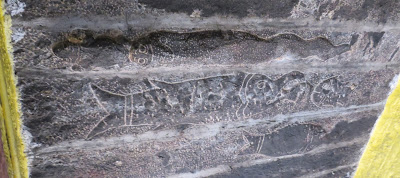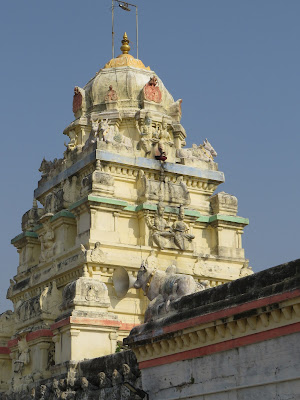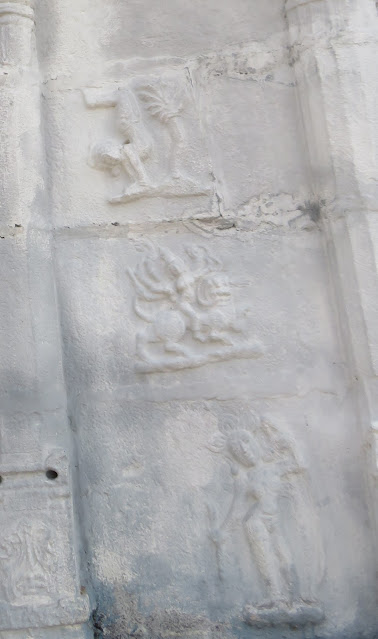Thaiyur Murugeeswarar Temple
I thought it would be a typical day for me to explore some unknown or lesser-known sites. But, when I stumbled upon this temple a few months ago, I literally turned speechless. I never heard or imagined such a temple existed in Chennai. With hundreds of miniature bas-relief images beautifully sculpted and with the sculptures of Pallava and Vijayanagara periods, it is the best-kept secret of Chennai. It is a paradise for art lovers and history enthusiasts. I pity myself for not exploring this unknown gem so far.
I will not hold you more - let me reveal the name. Join me in exploring the beautiful Murugeeswarar Temple of Thaiyur.
Introduction
Thaiyur (pronounced as Taiyur) is situated at a distance of 8 km from Tirupporur and 42 km from Chennai. Real estate development on Old Mahabalipuram Road (OMR) has made this southern neighborhood of Chennai popular nowadays. However, not the ancient temples of the village turned so famous.
Google Map location (coordinates) is provided at the end of the article.
Legend
As per the sthala purana (local legend), Murugan (also known as Kartikeya, Subramanya or Skanda) worshipped Lord Shiva in this site before proceeding to the nearby Tirupporur battlefield, where he had to fight against the Asuras. It is said that the holy tank located behind the temple was formed by him.
History
The sculpture of Ganesha in Maha mandapa can be dated to the late Pallava era (9th century CE), as per its style. The base of this sculpture has a single line of inscription. It reads "Sree Urumettru". Besides this, the icon of Chandikeswarar is also believed to be from the 9th or 10th century CE. Purely, based on these two sculptures, we can assume that the original temple might have been built during the Pallava era. There is no other literary or epigraphic evidence, though. (Reference - Kalvettu Magazine January 2005).
On the plinth of the west wall of Maragadavalli Amman Shrine, an inscription of Jatavarman Sundara Pandya I is found. I presume the inscription is dated 1268 CE. It records the donation of the land made by six people from Tiruvidandai to this temple. The presiding deity is referred to as Nayanaar Azhagiya Chokkanaar. (Reference A.R.E. 222/1915-16).
There is another inscription found in the Maha mandapa dated 1536 CE during the reign of the Vijayanagara King Achyuta Deva Raya. As per the details provided in the inscription, we understand that the alternate name of the village was Rajakesari Nalloor and it was part of Ayiram Veli Pattru, a sub-division of Kumizhi Nadu of Aamur Kottam. It calls the deity as Tiru Murugeeswaramudaiya Nayanar. (Reference A.R.E. 223/1915-16).
Another inscription found in the Mukha mandapa is probably dated to 1565 CE during the reign of Vijayanagara King Tirumalai Deva Maharaya. It mentions the deity as Tiru Murugeesuramudaiya Tambiraanar. (Reference - Kalvettu Magazine January 2005).
I believe that the original temple as a brick structure existed during the Pallava period. Later, it was rebuilt. As no Chola's artwork is found, it is not known who rebuilt the shrine of Murugeeswarar (Shiva). The shrine of Maragadambikai (Goddess) appears to be older than the main shrine. Hence, we can conclude that this structure was rebuilt for the second time during the Vijayanagara period.
The shrine of Goddess was built in the 13th century CE by the Pandyas.
Besides reconstructing the sanctum and ardha mandapa, the Vijayanagaras have extended them with Maha mandapa and Mukha mandapa. The innumerable bas-relief images found all over the outer walls are definitely the result of the imagination of Vijayanagara sculptors. The period can be either 15th or 16th century CE.
A few more historical tidbits about this village...
The place was known as Sthalasayanapuram before the period of Rajaraja Chola I. It should be noted that the Vishnu temple in Mamallapuram is known by that name. Hence, it appears that there was an ancient Vishnu temple here.
Possibly, this village was named after Rajaraja Chola I as Rajakesari Nallur. Nearby Sembakkam village was known as Parakesari Nallur. (Rajakesari and Parakesari are two titles used alternatively by the Chola rulers).
Tiruvidandai temple's inscription has references to this village. Similarly, the inscription from this village mentions Tiruvidandai.
In the 15th century CE, a chieftain named Uthandan, serving the Vijayanagara Kings, ruled Thaiyur. A poet had composed 450 songs on him. The collection called Uthandan Kovai talks elaboratively about Thaiyur. (Kovai is a Tamil literature form, where the verses are arranged in a thematic sequence.)
Seven Temples
There are seven prominent Shiva temples around Tiruvaiyaru called Sapta Sthana Sthalams. Most of us know that.
Similarly, there are seven ancient Shiva temples in the Mylapore locality of Chennai. They are also known as Sapta Sthana Sthalams. Some of us might know this already.
None of us might know that even Thaiyur has seven ancient temples of Shiva. They were once known as Sapta Sthana Sthalams of Thaiyur.
After talking to many elders of the village, I managed to collate the list of all these temples with great difficulty. However, there is a slight difference of opinion in the identification of the seventh temple. Here goes the list.
1. Chenkanmaaleeswarar
2. Mareeswarar
3. Murugeeswarar (the temple on which this article is written)
4. Jalakandeswarar
5. Azhageesar
6. Komaleeswarar
7. Abhatsagayeesar or Baleeswarar of Sozhathangal (or) the temple inside the forest of Chenkadu
Murugeeswarar
The presiding deity of the temple is Murugeeswarar. He is in the form of a Shiva Linga of about three feet high. He is enshrined in the east-facing Garbha griha (sanctum).
As per Agama Shastra (traditional temple rules), Shiva Linga should always be accompanied by Uma. In many temples, the metal icon of the Goddess is enshrined within the sanctum. In this form, she is called Bhoga Shakti. The highlight of Murugeeswarar and a few other Shiva temples in Thaiyur is that Bhoga Shakti is found as a stone sculpture. The temple authorities call her Piriyavidai.
Not sure how many devotees notice this. When you visit the temple, ensure that you worship Murugeeswarar along with his Bhoga Shakti in the sanctum.
 |
| Murugeeswarar with Bhoga Shakti (Photo courtesy - Mr. Uma Mahesh, Thaiyur) |
Ardha Mandapa Sculptures
Interestingly, the Ardha Mandapa (the enclosure outside the sanctum) has many relief images, which is rare.
The outer wall of Garbha griha has many fascinating miniature bas-relief images. It is unusual to find such images in this section.
The true right side pillar of the sanctum has the bas-relief images of Bhuta Gana, a dancing girl and a devotee performing pooja to Shiva Linga. The true left side pillar has the icons of Purushamriga, a dancing girl and a devotee worshipping Shiva Linga.
The sanctum's true right side outer wall has the miniature images of a man along with a fish (probably depicting Matsyendra) and a Shiva Linga with two female devotees with their arms raised upwards in worshipping posture.
The sanctum's true left side outer wall has the icons of a tortoise (Kurma Avatar?) and a Shiva Linga with a Vimana-like structure with a couple of devotees.
The ceiling of Ardha mandapa has a decorative element in the middle, Purusha mriga, two Shiva Ganas and an unidentifiable deity in four corners.
The pilasters at the mandapa entrance are adorned with pleasing images of Ganga, Yamuna and various other deities. It should be observed that we usually find such sculptures at the Gopuram (tower) entrance and not at the Ardha mandapa in South Indian temples.
The outer side of the entrance has small relief images of Dwarapalas. The exterior walls have the icons of Kubera, Sankha Nidhi and Padma Nidhi.
Thanks to Vijayanagara kings for turning this mandapa a remarkable one. It is unusual to find so many relief images in Ardha mandapa. And, it is unfortunate that even the regular visitors of the temple are unaware of this fact.
Pallava Ganesha
Maha Mandapa (the enclosure outside Ardha mandapa) has many exciting features too.
The most fascinating sculpture is Ganesha, which is probably a later Pallava-era icon. As stated already, it has a single-line inscription at its base. Located at the south end of the mandapa, Ganesha is in the sitting posture. The features are visibly different from the latter period typical Ganesha icons. He holds mazhu (battle axe) in his upper right arm, and his trunk is turned towards his right side (called Valanchuzhi). Both these features are not commonly found.
Swayambhu Murugan with Chandikeshwara
Near Pallava Ganesha, Murugan is found flanked by his consorts Valli and Devasena. His vahana peacock is seen in front of him. It is usual as we find in any other temple. However, what is unique is the presence of Chandikeshwara near him. The typical location of Chandikeshwara is south facing sub-shrine in the prakara. Hence, it is considered very special.
 |
| Swayambhu Murugan |
Also, the sculpture of Murugan seems to be eroded due to age. However, as per the religious belief, it is a self-manifested icon called Swayambu Murugan. It is said that the exact replica of this sculpture is found in Tirupporur Murugan temple.
A Shiva Linga (named Kasi Viswanatha) is also found along with his son and daughters-in-law. This group of sculptures probably depict the legend of Murugan getting the blessings from Shiva before proceeding to the battle in Tirupporur.
 |
| Murugan with Chandikeshwara |
Vijayanagara Murugan
On the north end of Maha mandapa, the sculpture of Murugan is situated. It is a testimony to the remarkable workmanship of Vijayanagara sculptors. Kartikeya is found stylishly seated on a peacock with his left leg folded and right leg hanging down. He holds Shakti and Vajra in his upper arms. The temple authorities currently call him Shanmukha, which is not correct.
Other Icons of Maha Mandapa
Besides Pallava Ganesha, Vijayanagara Murugan and Swayambu Murugan, there are a few other sub-shrines/icons in Maha mandapa. Let me brief you about them too.
A small image of Nandi is found facing towards the sanctum.
Adjacent to Vijayanagara Murugan, Nardana Vinayaka is located.
Maha mandapa has six pillars. The relief images on those pillars are visible properly as they are all painted in bright colors.
The sub-shrine of Nataraja houses the processional icons of Uma and Maheswara. They are newly made images. Eleven old panchaloha icons, including Nataraja and Sivakami, are under the safe custody of the Government, somewhere else.
Maragadambika
Maragadambika, the presiding Goddess, is enshrined in a south-facing sanctum. A 16-pillared mandapa connects this shrine with the above-described Maha mandapa.
Maragadambika is in the standing posture. She holds angusha and pasha (noose) in her upper arms. Her lower arms are in abhaya and varada mudras.
Her sanctum extends into an ardha mandapa. Her vahana, lion, is found in front.
This shrine appears to have been built originally by the Pandyas and renovated in the later period.
 |
| Maragambikai (Photo courtesy: Mr. Uma Mahesh from Thaiyur) |
Sculptures of 16-pillared Mandapa
As stated already, a 16-pillared mandapa connects the shrine of Murugeeswara and Maragadmbika. It acts as the Maha mandapa of Maragadambika and as a Mukha mandapa of Murugeeswara. It has gateways in the east and south directions, opposite the Murugeeswara shrine and Maragadambika shrine, respectively.
 |
| Bhairava |
There are 16 pillars in this mandapa studded with many interesting sculptures done during the Vijayanagara period. The modern-day paint coat on those pillars dissuades us from appreciating the beauty of these sculptures.
There are many deities found in this hall. Parashakti, the Goddess in the standing posture and Bhairava face south direction. There are eight serpents coiled the body of Bhairava. This is possibly a Vijayanagara period icon.
Three icons of Nagas and Mahavishnu in the standing posture are found facing the east direction.
Surya and Chandra are found in their usual locations diagonally facing the main sanctum. These sculptures and that of Nagas appear to have been made in the 20th/21st century CE.
No space in the ceiling is left out. It is full of many figures of bigger and smaller fish, various forms of snakes and tortoises. Though it is common to find such images on the ceiling in many temples, it is uncommon to find them in such a large number.
Nandi Mandapa
Opposite the east entrance of the 16-pillared mandapa, the old sculpture of Nandi is found. Behind it, we have common elements such as the bali peetha (offering platform) and dhwajastambha (flagstaff).
Koshta Devas
Ganesha, Dakshinamurti, Vishnu, Brahma and Vishnu Durga are found as the Pancha Koshta Murtis on the outer walls of the main shrine.
The image of Ganesha appears to be of the later Chola period. Dakshinamurti probably belongs to Vijayanagara era. Vishnu and Brahma may not be more than 100-150 years old. Durga seems to be an ancient sculpture, but I am not too confident on the same.
Pallava Chandikeshwara
Chandikeshwara is found in his usual location in a tiny sub-shrine near the Koshta of Durga. It is one of the oldest sculptures found in this temple. It probably belongs to the late Pallava-era (9th century CE).
Miniature Sculptures
The most beautiful feature of the temple is the innumerable miniature images found on the south, west, and north outer walls of the main shrine. Nowhere else in and around Chennai I have seen so many bas-relief images together. They are all undoubtedly the beautiful workmanship of Vijayanagara artists. Unfortunately, as the walls are entirely whitened, it is difficult to notice or identify a few sculptures.
The niche of Ganesha is flanked by two images. One of them is probably Skanda. Further beyond them, Surya and Chandra are found on either side.
On either side of Dakshinamurti's koshta, there are five sages found in different postures.
Unni Krishna, a squatting lion, Shiva Linga, Karaikkal Ammaiyar, a hunter, Mahisasuramardini, Kinnara couple, Tapas Kamakshi, Kamakshi hugging Shiva Linga, Uma performing pooja to Shiva Linga, a seated sage, Kannappa Nayanar with his leg on Shiva Linga, two people fighting, a cow releasing its milk on Linga, are some of the images found on the southern wall.
Indra seated on an elephant, Agni seated on a ram, Ganesha, Vishnu seated on Garuda, Lingodhava, Krishna playing the flute, Nataraja, Skanda with a peacock, Veera Bhadra, Bhairava, and a few other forms of Shiva are some of the images found on horse-shoe shaped elements called Nasis on the same wall.
Bheema and Purushamriga worshiping Shiva Linga, Uma Mahesa, a few devotees, Uma and Maheswara seated on Rishabha and blessing a man (Arjuna?), Lakshmi Narasimha, a man performing penance (Arjuna?), a man holding bow and arrow, a person performing pooja to Shiva Linga, are some of the images found on the western wall.
Uma Mahesa, two forms of Goddess, Purushamriga, Linga flanked by two devotees, Linga, Shiva seated, Kannappa Nayanar are some of the images found on Nasis on the same wall.
Kannapa Nayanar, Nataraja, Shiva in sitting posture, Bhikshatana, an elephant worshiping Linga, Adhikara Nandi, Mukha Linga, cow pouring milk on Linga, Rishabha aruda, Vayu seated on an antelope, Brahma, Gajasamhara murti, Kubera seated on a human, Kali, Isana seated on a bull are some of the images found on Nasis on the north wall.
A couple performing pooja to Linga, Dharmashasta, Bhikshatana, a sage, a devotee, a couple of devotees, Purushamriga performing pooja to a Linga and Linga with a serpent coiled on it are a few images on the north wall. The series of sculptures depicting the legend of Arjuna's penance towards Shiva, Shiva appearing as a hunter and wrestling with Arjuna and ultimately meeting him in his own form along with his consort seated on Nandi are all beautifully picturized.
Also, all Kumbhapanjaras (decorative motifs) across three sides of outer walls have tiny sculptures of various animals such as elephants, monkeys and lions.
Entrance
The entrance of the temple is east-facing. There is no gopura (tower). The bas-relief images of Ganesha and Kartikeya holding a bow are found on the outer walls.
The holy pond is located on the backside of the temple.
Happy travelling.
Thanks to Mr. Uma Mahesh from this village, who helped me to explore the temple well. He has been dedicating his free time towards the maintenance of the temple for the past several years. His dedication and service are highly appreciable.















































.JPG)
Very Divine and very useful information. I have been to Sri Tirupor Murugan temple many times when i studied near Padur. Happy to hear more Divinity around here
ReplyDelete